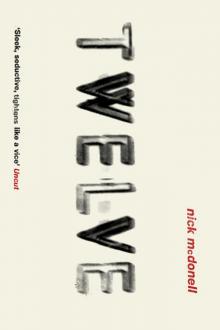- Home
- Nick McDonell
The Widow's Network (Kindle Single) Page 3
The Widow's Network (Kindle Single) Read online
Page 3
“Didn’t they know,” he asked, “that families were living in that area, and in that house? How could they bomb that house, knowing many families live in houses surrounding [it]?”38
I told Nazhan what I knew. Sabrine had explained that she’d wanted to warn the people in Kadisiya Two—like Nazhan, whom she’d known since childhood—about the air strike. “I was concerned,” she told me, “but I couldn’t tell anybody about it, because then I would become a target. I wanted to be a spy and not get caught.”39 Wahida and Talat both echoed her desire to avoid civilian casualties—even as they admitted to causing them.
Official US policy takes a similar line. On July 1, a few weeks before Nazhan and I met, President Obama had unified the policy40 with an executive order.41 In it, he asserted that minimizing civilian harm is a core national interest. Sarah Holewinski, longtime director of the Center for Civilians in Conflict, described the order to me as “bold.” In the wider context of armed conflict, she was right, even though the order is essentially a best-practices guide that institutionalizes an annual report. CENTCOM has actually held the order’s position since the beginning of the war, while simultaneously tolerating a certain number of civilian casualties based on what’s called the Non-Combatant Casualty Cutoff Value.42 This is the maximum number of dead Iraqi civilians US forces view as legal collateral damage in a military action—a ceiling. In May, I asked the then spokesman for US forces in Iraq Colonel Steve Warren if he could provide that number.
“There [are] numbers,” he told me. “We don’t put those numbers out, and here’s why we don’t put ’em out, because if the enemy understand, ‘[O]h if I have X number of civilians around a thing,’ it’s gonna be harder for . . . right? So that’s a piece of information that we protect.”43
In December of 2016, this number was reportedly ten. It had increased over the course of the air campaign—for the sake of efficiency, according to Colonel Warren. Several Iraqi officials confirmed that it changed because of their repeated requests to the Americans for more aggressive support.44
“So,” I finished telling Nazhan, “people argue about how high this number should be—should it be five, should it be ten, should it be twenty?”
The interpreter began to translate, but Nazhan interrupted.
“I understood what he meant,” Nazhan said, “like, two civilians and one hundred ISIS members are in the same area, right?”
“Yes,” said the interpreter.
“So [the Americans] favor the hundred ISIS members over the two civilians?”
“Yes.”
“Why then,” asked Nazhan, “in [Americans’] normal life, if a group of terrorists took over a place and held one hostage, would the entire world try to save that one hostage?”
I didn’t have an answer for that. We kept talking, and after a few minutes, Nazhan asked me a related, perhaps unavoidable question: “Is one life worth more than another?”45
Generally, I wanted to tell him, US policy is based on the premise that Americans are worth more than foreigners. This is partly why the United States works with problematic partners like Wahida, who are often making difficult compromises of their own. This didn’t seem like the right thing to say to Nazhan just then, however. Certainly, it hadn’t come up in the conversations I’d had with Sabrine about the air strike—though, in the house where Wahida had delivered the mutilated corpse, I’d asked her about Sara’s death and civilian casualties generally. Sabrine, who at that moment happened to be running her hands through her son Mohammed’s curly hair, said, “It is sad, but what can you do?”
Wahida, second from right, three of her “girls,” and two of their sons. Sabrine declined to be photographed.
NOTES ON SOURCING
This article is based on research conducted in Baghdad, Tikrit, and Washington, DC, from April to August of 2016. Certain elements of the story rely on a single source—for example, Sabrine’s encounter with the shepherd who helped her flee Hawija, and Nazhan’s encounter with the ISIS fighters demanding water. I used the single-source material only when, in my and my colleagues’ view, it was credible as well as consistent with other interviews and/or official documents we’d acquired, and with the historical record. Direct quotations (save two, see notes 3 and 22) are taken from thirty+ hours of recorded interviews. These were translated at the time by Bader Kata, an experienced (New York Times, BBC, CNN) Iraqi fixer/interpreter; many were subsequently retranslated and transcribed by Jennifer Hagan and her team at Word for Word Language Services.
Regarding comment from ISIS, so far, I have been unable to contact any of the ISIS fighters described in this story. There is, however, reference46 to Wahida as an enemy spy in one of the group’s Facebook posts.
With regard to US involvement, last year, I made repeated (seven+) requests to interview anyone attached to the Tampa- and/or Baghdad-based CENTCOM teams responsible for preventing and reviewing civilian casualties. Since an initial response that my request was under review, there have been no updates. A spokesman at the State Department whom I approached on the topic at the time wrote me that the State Department does not track civilian casualties, and referred me back to the Department of Defense.
ABOUT THE AUTHOR
Photo © Walid Fazly
Nick McDonell graduated from Harvard and St. Anthony’s College, Oxford. He is author of the novels Twelve, The Third Brother, and An Expensive Education; a book of political theory, The Civilization of Perpetual Movement; and a history of civilian casualties in American wars, Solatia, to be published in 2018.
Text copyright © 2018 by Nick McDonell
All rights reserved.
No part of this work may be reproduced, or stored in a retrieval system, or transmitted in any form or by any means, electronic, mechanical, photocopying, recording, or otherwise, without express written permission of the publisher.
Published by Amazon Original Stories, New York
www.apub.com
Amazon, the Amazon logo, and Amazon Original Stories are trademarks of Amazon.com, Inc., or its affiliates.
eISBN: 9781503954908
Cover design by PEPE nymi, Milano
NOTES
1 The neighbors who helped clear the rubble were Ahmed al Faris and Mohammed Khidhir.
2 Um Mohammed, interview with author, May 21, 2016.
3 My recorder was off for this, but it was such an unusual exchange that I am confident in my recollection.
4 Saleh Jabouri, interview with author, July 22, 2016.
5 Aseel Kami, “The Daily Struggle of Iraq’s Widows of War,” Reuters, November 9, 2011, http://www.reuters.com/article/us-iraq-widows-idUSTRE7A841T20111109.
6 Andrew E. Kramer, “After Nearly 9 Years of War, Too Many Widows,” New York Times, November 24, 2011, http://www.nytimes.com/2011/11/25/world/middleeast/iraqi-widows-numbers-have-grown-but-aid-lags.html?_r=0.
7 “Exhumation of Iraq’s Camp Speicher Victim Mass Graves Begins,” Reuters, April 7, 2015, http://www.reuters.com/article/us-mideast-crisis-iraq-speicher-idUSKBN0MY0WR20150407.
8 “Ruinous Aftermath: Militias Abuses Following Iraq’s Recapture of Tikrit,” Human Rights Watch, September 20, 2015, https://www.hrw.org/report/2015/09/20/ruinous-aftermath/militias-abuses-following-iraqs-recapture-tikrit.
9 Ghazwan Hassan, “Iraq Dislodges Insurgents from City of Samarra with Airstrikes,” Reuters, June 5, 2014, http://www.reuters.com/article/us-iraq-security-idUSKBN0EG1RG20140605.
10 See documents provided by Mike.
11 Fat Mike, interview with author, July 17, 2016.
12 “Android Windows Tactical Assault Kit,” December 12, 2017, https://atakmap.com/p_about.aspx.
13 Mohanad N. Mohammed, interview with author, July 19, 2016.
14 Um Mohammed, interview with author, July 18, 2016.
15 Ali Adwan, b. 1968; Aus Ali Adwan, b. 1994; Inas Ali, b. 1998; Noor Ali, b. 1992; Hahnia Ali, eight years old; Oras Ali, four years old; Mohammed Ali, fourteen years old; Taha Ali, nine years old;
Abdel Qader Ali, ten years old; Othamn Ali, seven years old.
16 Rod Nordland, “Iraq Forces, Pushing ISIS Out of Tikrit, Give Few Thanks for U.S. Airstrikes,” New York Times, April 3, 2015, http://www.nytimes.com/2015/04/03/world/middleeast/isis-forces-pushed-out-of-tikrit.html.
17 Luke A. Wilson, SPC US Army CENTCOM CJTF OIR, email message to author, August 29, 2016, following repeated requests:
Here is your query and our response.
Q1. I’m looking for confirmation and/or comment on a[n] Iraqi officer who claims to be running an intelligence network in Saladin and elsewhere[,] which is providing intelligence used in US air strikes. Can we have a conversation about this, at your earliest convenience? I would like to make sure I get the coalition side of the story properly.
A1. We utilize intelligence from multiple sources on the ground and through ISR in order to validate targets for air strikes. For operational security we will not release any information in regards to our allies on the ground.
18 Talat Issa Khalaf, interviews with author, May/July 2016; Abu Turab Thamer Hussein, interview with author, July 25, 2016; Um Hannadi, interviews with author, May/July 2016; Um Mohammed (with Huda, Hannadi, et al.), interviews with author, May/July 2016.
19 John W. Hesterman III, interview by Steve Warren, “Department of Defense Press Briefing by Lt. Gen. Hesterman via Telephone from the Combined Air and Space Operations Center, Southwest Asia in the Pentagon Press Briefing Room,” June 5, 2015, http://www.defense.gov/News/Transcripts/Transcript-View/Article/607056.
20 No one else was willing to confirm this, and I did not confront Sabrine on the point; by the time I heard this, our security situation had deteriorated in Tikrit, and I was concerned about making an enemy of Sabrine by asking the question. My interpreter believed it would be perceived as an accusation, and I agreed.
21 Ali Soudani, former director of military intelligence for Saladin, unrecorded interview, August 29, 2016.
22 Um Hannadi, interview with author, July 17, 2016.
23 Um Hannadi, telephone conversation overheard and translated by Bader Kata, July 2016.
24 22 U.S. Code § 2378d.
25 Um Hannadi, interview with author, July 17, 2016.
26 Nordland, “Iraq Forces.”
27 Christiaan Triebert, “1,000 Days of War: The Geolocation Challenge,” Airwars.org, May 5, 2017, https://airwars.org/news/1000day-geolocations/.
28 Barak Obama, “Statement by the President on ISIL,” September 10, 2014, https://www.whitehouse.gov/the-press-office/2014/09/10/statement-president-isil-1.
29 Um Hannadi, interview with author, July 20, 2016.
30 Nahadat Ali’s Facebook page, posted August 6:
Headline: Um Hannadi Leading Unit of Special Forces to Destroy ISIS
This is the first woman who got a position to lead a unit in Saladin. After her husband was killed and now she works under the control of Saladin operations, and also with the Mobilization. She says many women join her from Sharqat as fighters. She lost seven martyrs from her family. ISIS killed four of her brothers and her father after they refused to join ISIS. They also killed her first husband, and her second husband, who was with her as a fighter. She has two daughters[;] one of them is arrested in Sharqat with her husband. ISIS cut the arm and leg of her husband. The second one was released from Sharqat and has been fighting terrorists since 2004. In one operation she killed eighteen of ISIS on the orders of Saladin Operations Command. Um Hannadi goes forward now to Qayarrah and will use it as a base for her special forces to liberate Mosul. She has a good plan to save civilians in Mosul, and not to lose fighters. She has fifty fighters with her and they look like one family. She swears to support all the security forces when they need her.
C. F. Sadaan Al Jabhan / The Front Line; Website of Ali al Ghazi / “One thousand years ago there was a strong woman named Howla bint Al Azwar, and now we have Wahida Jumaili.” March 3, 2016.
31 Wahida posted what appeared to be a recent picture with Muhandis. Wahida Muhammad’s Facebook page, accessed August 17, 2016, https://www.facebook.com/people/%D9%88%D8%AD%D9%8A%D8%AF%D9%87-%D9%85%D8%AD%D9%85%D8%AF/100010746751728.
32 Um Hannadi, interview with author, July–August 2016.
33 “I don’t let the number overwhelm me. I focus on two to three people . . . I talk to them and see what they have to say. Then they call me, and I try to ask them the same questions and see how they respond and how they act. Do they act in the same way as before . . . [or] do they give excuses and act with cold nerves?”
34 Um Hannadi, interview with author, July 20, 2016.
35 I was unable to locate these Peshmerga soldiers, but the claim is credible.
36 Colonel Talat, interview with author, May 21, 2016.
37 Fat Mike, interview with author, July 17, 2016.
38 Mohanad N. Mohammed, interview with author, July 19, 2016.
39 Um Mohammed, interview with author, July–August 2016.
40 Sarah Holewinski, email correspondence, August 22, 2016.
41 Exec. Order No. 13732, https://www.whitehouse.gov/the-press-office/2016/07/01/executive-order-united-states-policy-pre-and-post-strike-measures.
42 For a longer explanation of this complicated topic, see: Ali Watkins, “The Numbers Game,” BuzzFeed, February 28, 2016, https://www.buzzfeed.com/alimwatkins/syria-civilian-casualties-policy?utm_term=.kuqQRg0DL#.pe99bKa1J.
43 Steve Warren briefing, May 9, 2016.
44 When the campaign against ISIS began, the NCV was 0. The increase was not reported until early 2016. This time frame is consistent with my own reporting.
45 Mohanad N. Mohammed, interview with author, July 19, 2016.
46 Baghdad al Monsour @neserST’s, Facebook page, posted August 2016: “Um Hannadi is a spy who works with Saladin intelligence [who] has recently been assigned [as] director of Samarra with the Hashd al Juhashi.” (The phrase, a play on the term for the Shiite militias, is Iraqi slang for “buffalo.”)

 The Council of Animals
The Council of Animals The Widow's Network (Kindle Single)
The Widow's Network (Kindle Single) The Widow’s Network
The Widow’s Network Twelve
Twelve